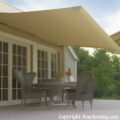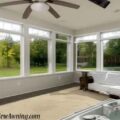| Awning |
A metal or wood frame covered by a fabric to provide shade. |
| Canopy |
A fabric covered covered metal or wood frame that is attached to the building on one side with support legs on the other side. |
| Popup Tent |
A standalone structure usually consisting of 4 metal poles and a fabric covered roof |
| Stationary Awning |
This is a type of awning that is securely attached to the building. It does not contain hinges or moving parts and either has to be in place to provide functionality or taken down before large storms. |
| Retractable Awning |
This is a type of awning that contains hinges so that it can be folded up before the winter or large storms. |
| Motorized Awning |
This is a type of retractable awning that uses an electric motor to extend the struts or wind up the leechlines. |
| Manual Awning |
This is a type of retractable awning that uses crank or leechline and jam cleat to fold up the awning. |
| Leechline |
This is a weather resistent strong cordage used in boating. For us, this is used to attach the fabric to the frame. |
| Jam Cleat |
This is a hardware fixture that is attached to the building which ties down the leechline. |
| Grommet |
This is a hole surrounded by the small metal ring in the fabric. |
| Classic Stripe |
This is an awning pattern which features the two alternating color patterns. The bars are approximately 3.8″ apart. |
| Acceleration Stress |
This occurs when the fabric is in high wind and pulls on the leechline. This can lead to either tearing in the fabric or snapping in the leechline. If you live in a region with strong wind, you may wish to check with the manufacturer to determine if this type of damage is covered in the warrany. |
| Epoxy Anchor |
For brick or stone homes, this is used to attach reinforce the headboard to the side of the building. |
| Aluminum Pipe |
This is a standard metal pipe compose of lightweight aluminum. It weighs about 1/3 the amount of a steel or galvenized pipe of the same diamter. |
| Anchrorage |
This is the term used for describing the fixtures which attach the awning or canopy to the building. |
| Awning Cord |
This is the commonly used term for leechline. |
| Bias |
This is the technical term for the slope of the awning. You may read this in manuals such as a 30 degree bias. |
| Bolt-Through |
This is the term used to describe an extremely long bolt that goes entirely through the exterior wall. This is rarely used outside of portable awnings for either vehicles or in the tiny house movement. |
| Braid |
This is a wound piece of fabric that is often used as edging or on a valance. It can be created from an entirely different color as it is a separate piece that is sewn on. |
| Tensile Strength |
This is a measure of the amount of force required to either tear the fabric or snap the awning cord. |
| Cadmium Plating |
This is a very upscale finish used to protect steel or iron framing. This is similar to galvenized pipe which use zinc; however, cadmium provides better protection from the elements. |
| Galvenized Plating |
This is a commonly used technique for protecting the steel or iron frame from weather damage. The metal is coated in zinc. |
| Calendaring |
A technique of moving the fabric between two or more rollers to produce specific patterns. This should not matter to most homeowners, and we are only including it so there is no misundertanding if it’s in the manual. |
| Canvas |
This is a type of awning fabric that is woven. It is constructed of polyester or linen. After the weaving is complete, it will be covered in a polymer to create a water resistent surface. |
| Cordage |
This is an generic industry term for describing any rope or line used for the awning. |
| Crazing |
This is a term used to describe the damage that can come from folding or creasing the fabric. This usally only impacts the look with no impact on the functionality. This is often specifically called out as not covered in warranties. |
| Corcking |
This is the industry term used when the color fades or is rubbed off. This may be covered in warranties depending on the cause. This will often be classified under the more consumer friendly name of “Color Fading” |
| Delamination |
This is when the layers of the fabric split and begin to pull apart. This is different than a tear which is when the fabric is “torn” throughout all layers of the fabric. This is more like the appearance of pulling a sticker from its backing. |
| Denier |
This is an industry term used to measure the weight of the fabric. This will determine the threadcount of the material and can be used to calculate the weight to ensure the frame is structurally sound. |
| Die Casting |
This is the process of extruding liquid metal into molds. This is commonly down with Zin and alumimum. |
| Dimensional Stability |
This is a measure of evaluating how stretching the fabric will be. Materials such as spandex or lyrca have an incredibly low dimensional stability whereas denim would be high on this. |
| Expansion Anchors |
A common mounting fixture that attaches the headboard to the side of a concrete building. |
| Fiber |
This is an industry term which defines what material is used in the awning fabric. This can commonly be wool, cottom, polyester. It is now a very broad term and can include many synthetic materials. |
| Fire Proof |
This is a material that will not catch fire under any circumstances. Most awnings are *NOT* fire proof so if you need this then please verify with the manufacturer. |
| Fire Retardant |
This is a fabric that is coated in material to resist flames. Given prolonged exposure to a fire, the material can eventually lead to the underlying materially burning. |
| UV Resistent |
This is an industry term which describes how well the material blocks the ultraviolet rays from the sun. This is often written in terms of a percentage such as 80% UV meaning that 80% of the rays are blocked. |
| Hydrostat Pressure |
This is an industry term which measures the awnings ability to standup during water pressure. This is something that the homeowner may want to check before using a powerwasher to clean the awning. |
| Lacing |
This is a process of connecting the fabric to the frame. This uses grommets places near the edge of the fabric that are attached to the struts and frame via the leechline. |
| Lateral Arm Awning |
This is a type of retractable awning in which there is a folding strut at each side of the awning. When the internal gears are turned either through a motor or manual crank, the struts straigten to create an extended awning. The process is reversed to retract the awning. Think of the struts like your elbow where they arm is straight when the awning is out, and retracted when you bend your elbow to place your hand on your shoulder. |
| Loose Frame Awning |
This is a type of retractable awning that has a headbar, forbar, and horizontal struts; however, there are no metal frame on the bias. The awning is merely held in place by the tension from the fabric. |
| Mildew Proof |
This is the process of sparying the fabric with a non-toxic chemical to prevent the growth of fungus. |
| Monofilament |
This means the fabric is composed of a single type of fiber. This is the opposite of the polyfilament fabric. |
| Natural Fbier |
This is orgranic material such as cotton or wool. This is the opposite of polyester or acryllic. |
| Non-Woven |
This is the term used for fabrics that are connected toether using epoxy or other bind agent. While they can be less expensive, we are *NOT* fans of this type of fabric, it can lead to major fails if the binding agent fails. |
| Polyester |
This is a synthetic fiber that rates high in dimensional stability. It is also fire and UV resistent. This is a top choice fiber for most consumer shade needs. The only drawback come with its ability to get a true color. |
| Ponding |
This is an industry term used when the fabric begins to sag and then prevents water from draining properly. |
| Seam |
This is where two individual pieces of fabric meet. The ends can either be sewn or glued. |
| Solution Dyed |
This is an industry term in which synthetic fibers receive their color before they are woven into the fabric. This makes the color part of the structure itself making the color far more resistent to fading. |
| Stainless Steel |
This is steel that has been forged with either nickel or chromium. |
| Top Coat |
This is the industry term for a liquid material applied to the finished fabric. It is usually transparent that is either designed to improve the water resistence, fading or UV protection. |
| Adhesive Anchor |
These item are used to attach awning brackets to a brick home. |
| Tensile Strength |
This is the amount of force that a fabric or cordage can take before it snaps. |
| Cordage |
This is a generic term that refers to any and all types of ropes. |
| Valance |
This is the fabric that hangs from the front of the awning. Because this is such a large topic, we have created a dedicated valance style guide. |


